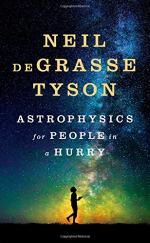|
This section contains 1,331 words (approx. 4 pages at 400 words per page) |

|
Summary
Tyson begins this chapter dedicated to dark energy honestly, as he claims it is one of the most “mind-warping” concepts in astrophysics (94). The study of dark energy dates to Albert Einstein, a theoretical physicist practicing in a time dominated by experimental physicists. Theoretical physics hinges on models; “a physicist’s model intends to represent the entire universe,” which he then warps with an equation, and manipulates the model accordingly (95). The most recognizable example of this process is Einstein’s general theory of relativity, which “outlines the relevant mathematical details of how everything in the universe moves under the influence of gravity” (96). Einstein’s theory continues to pass experimental tests to this day, a testament to the brilliance of his mind and the importance of theoretical physics. Tyson’s admiration is clear: “Yes, Einstein was a badass” (98).
When Einstein was devising his general theory...
(read more from the Dark Energy Summary)
|
This section contains 1,331 words (approx. 4 pages at 400 words per page) |

|




